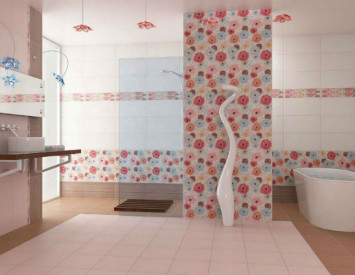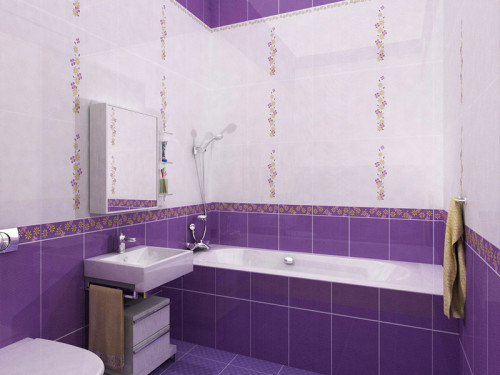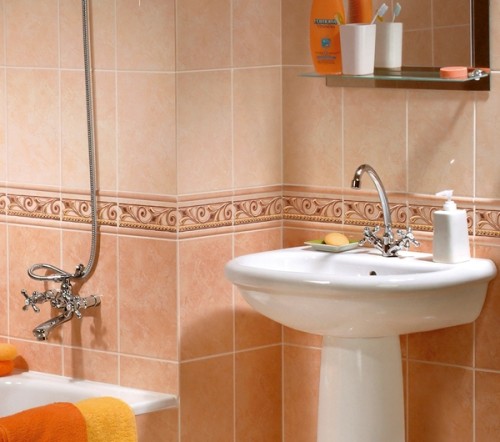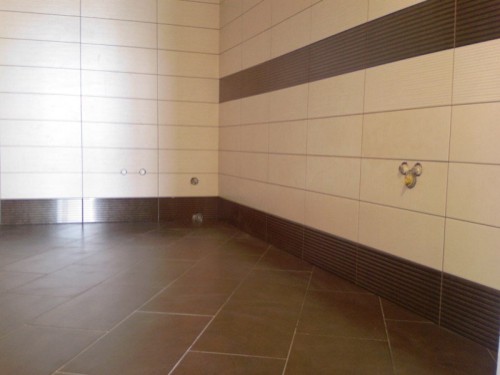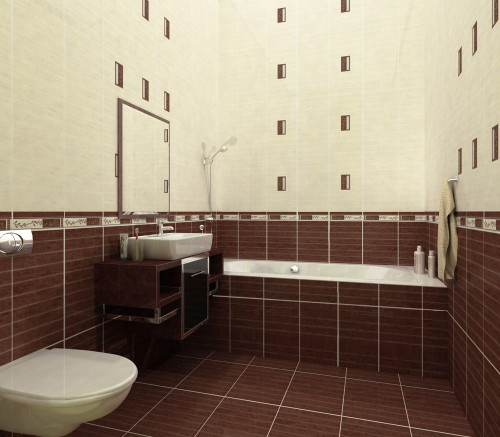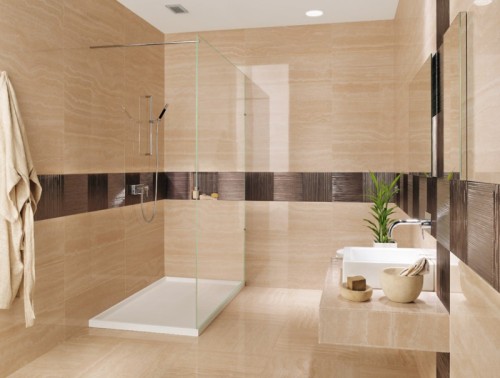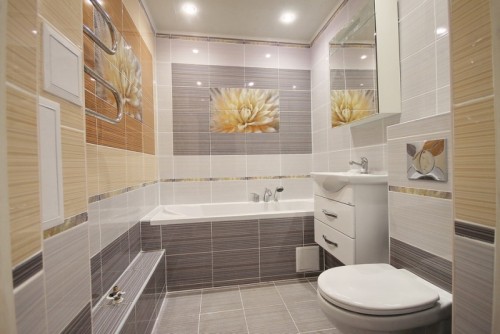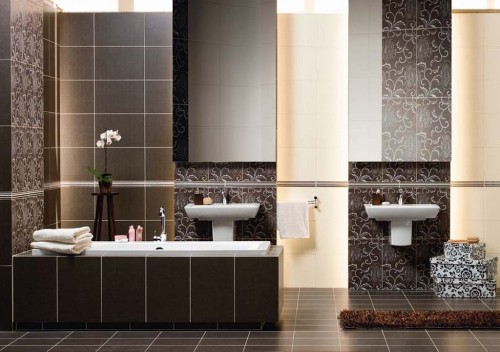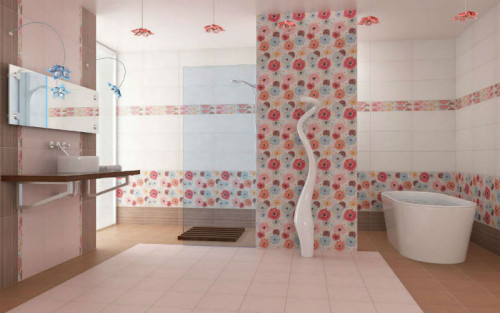For facing the bathroom, tiles are perhaps used most often. This material has a mass of operational qualities. Of the advantages, the strength and stability of tiles to abrasion should be noted. Thanks to this, it is used not only for wall decoration, but also of the floor. In addition, this material is resistant to moisture and pair, which makes it suitable for use in rooms with high humidity, for example, in pools and bathroom. It should also be noted its durability and hygiene. The surface lined with tile is easily washed and does not delay the pollution. In addition, today there is a variety of colors and shapes of this material, so that you can lay out any bathroom design with tiles. Given all the above advantages, this material is very popular. Next, we will talk about how to put the tile in the bathroom.
Content
Characteristics and features of the choice of material
We note the main "strengths" of this material:
- Tiles, first of all, are valued for high strength. The service life of the surface lined with it is large enough.
- In addition, this material is distinguished by fire resistance and does not emit toxic substances and smoke.
- It is also necessary to note the moisture resistance of this material, which makes the tile ideal for facing rooms with high humidity.
- Of the advantages, it is also necessary to note resistance to wear. Therefore, in the bathroom, ceramic tiles are lined with both the walls and on the floor. In addition, the wear resistance of this material is also said by the fact that many places of a large accumulation of people, for example, such as underground transitions and trading zones are mainly covered with ceramic tiles. So that the tile is not slippery today in the icing during manufacture add abrasive sand.
- It should also be noted the resistance of ceramic tiles to low temperatures, which makes it one of the most suitable materials for the external cladding of buildings.
- The surface lined with tiles is easy to wash. To do this, just wipe it with a damp cloth. In this case, you can use almost any detergent. After all, the tiles are resistant to chemicals, and even to the fact that they contain alkalis and acids.
- It does not fade from the effects of sunlight.
As for the shortcomings, the main thing is the expensive installation of this facing material. But these costs pay off due to excellent operational qualities that were listed above. Before proceeding with the laying of tiles, you need to remove the measurements from the walls, and on the basis of the obtained values, calculate the area. This will help to navigate the required amount of material. Moreover, it is better to take tiles a little more, because It is highly likely that part of the material in the process of work will go into marriage.
Today you can find a large assortment of tiles on sale. Among all this variety, it is difficult to make the right choice. First of all, you need to take into account the purpose of using the material. So, for example, for rooms with high humidity, the tile should have low porosity. The appearance of the tile also reflects its quality. The edges of high -quality tiles are smooth, the surface is without cracks and smooth. You can learn a lot of important information by packaging. In particular, the purpose of the tile is indicated in the form of a special drawing.
- So, if a foot pattern is depicted, this is a tile for the floor.
- There is an image of the hand - this tile is designed for walls.
- The foot pattern on a shaded background is a sign of wear -resistant tiles.
- A snowflake can also be depicted on the package - this means that the tiles are frost -resistant.
Methods for laying tiles in the bathroom
There are several ways to put tiles. The simplest is direct styling. This option is suitable for beginners and for those who cannot decide on the styling method. If the walls of the room are the same in height and width, then you can use a diagonal or chess version of styling. The first allows you to hide small surface distortions. The second way can be safely called classic. For it, tiles of two different colors are used, which during installation alternate following the example of a chessboard. For rectangular rooms, laying with a displacement is suitable. When this option is used, each subsequent row is laid at a certain distance relative to the neighboring one. The disadvantage of this method is a lot of cut tiles.
A rather complicated laying option is to lay out the tile with mosaics. For it, pieces of different sizes and colors are used. This is the main difficulty. Despite this with a great desire, even a person without experience can master this skill.
We have listed the main methods of laying tiles for the bathroom. In accordance with the surface plans selected from them, the future position of the tiles is marked with a pencil and ruler. In addition, places where decorative elements will be located are noted. The plan should be drawn up in such a way that there are no narrow places in the corners and places of adjoining, so that you do not have to cut the tiles. After completing the plan, based on it, you can already decide on the necessary amount of material.
Laying tiles in the bathroom
Work order:
- The initial step is the preparation of the work surface. This should be paid to special attention. First of all, you need to remove the coating from the walls, which is available on the surface before the repair. It is worth cleaning even the coating that holds reliably. If this is not done, then the tile after some time may begin to fall off.
- After this, the walls must be thoroughly cleaned of dust, and checked using the level how vertical they are. It is likely that as a result of such a check of the wall will be not quite even. Unevenness is usually aligned with plastering.
- You can start laying tiles only after the main preparatory work is completed. It is likely that during the laying process you will have to cut the tile. The fact is that very rarely the height of the walls is red to the dimensions of the tiles. In order to find out in advance whether it will be necessary to cut the tile, it is enough to divide the height of the wall of the room into the dimensions of the tile. If the result is not a whole, then you can’t do without cutting. In addition, in the process of laying, the tiles are located not close to each other, but with a certain interval of about 3.5 mm. Be sure to consider this moment when calculating.
- It is recommended to lay the tile in such a way that the cut pieces are below. So they will be least noticeable. But you should start laying not on top, but from below using a horizontal starting rail to leave a place below under a trimmed tile. From the floor it is necessary to measure the necessary height. It is at this mark that this rail is fixed. Moreover, it is necessary to check that it is strictly horizontal.
- To lay tiles, prepare a solution. To do this, you need a container of water and a dry mixture. It does not fall asleep immediately, but gradually, in small portions. After each portion, the product needs to be mixed. This is convenient to do with a construction mixer. As a result, a solution should be obtained, the consistency of which resembles the cream - it should not drain from the tile, but at the same time should easily smear on the surface.
- When the solution is ready, you can start laying tiles. To do this, you need a gear spatula. It is with this tool that it is convenient to apply the solution to the tile. After that, the tile should be pressed against the wall. The styling should start from below, not forgetting to fix the rail at the bottom, on which the first row will be based.
- With the next tile, the process is repeated. It is important that all the gaps are the same. For this, special plastic crosses are usually used. The gap between the tiles is needed in order to prevent the material from cracking due to thermal expansion. These crosses will help make the seams more the same and aesthetic.
- After laying the lower row on both sides of it, you need to put vertical strips and make sure their evenness by means of the level. To save time when laying the second row, you can stretch the thread at the height of one tile as a landmark. Then you will not need to check this row with the level.
- If as a result of the measurements it turned out that the tile will have to be cut due to the fact that the width of the wall is not multiple of the dimensions of the tiles, then try to put the pieces so that such places are in the corners or, as previously mentioned, below the wall. So the violation of symmetry will be less noticeable. By the way, tile cutter is often used for cutting tiles, but it is not suitable for every case. So, for example, to make a groove under the pipe in the tile, a grinder is suitable for this.
- Do not forget to periodically check the level of styling. After all, the quality of installation work depends on this. If this is neglected, then even a small skew can ruin the appearance of any tile.
- When the tile is laid, you need to carefully clean the surface of the residues of the mixture, and then let the solution dry and get stronger. While it dries, it is better not to enter the room at all.
- When the solution finally grabs, proceed to grout of the seams. Do not underestimate the importance of the grout. It can significantly improve the appearance of the processed surface. It is not worth saving on the grout, it is recommended to purchase an expensive small -dispersed mixture.
- When the grout is applied, it is recommended to remove all the excess funds as soon as possible. Especially if the plate has textured drawings. After hardening the grout, it can be very difficult to clean it.
Some secrets of laying tiles in the bathroom
Cutting tiles is often inevitable. Therefore, it is worth knowing some tips on how best to do it. So, before sharp, it is recommended to soak the tiles in the water for about an hour. Then mark the line on which draw a glass cutter. After that, combine the cut line with the edge of the table and press on top to break the tiles. You can put a thin stick under the cut line and press on two sides. As a result, the material should break exactly in the incision. The incision needs to be done only once, so that it passes from edge to edge. For cutting tiles, as mentioned earlier, they also use a special tool - tile cutter, but not everyone has the opportunity to get it. This tool is similar in appearance to glass cutter, only a rotating wheel is more and there is a special mechanism for breaking. A tile cutter is especially useful for a large amount of work.
Tiles on the walls are usually laid upward horizontal rows. Before starting work, you should make sure that the surface is even and horizontal marking was made. The solution for each tile should be applied with an even layer with a thickness of not more than 1.5 cm. After which the tile with the solution is strongly but gently, pressed to the working surface. So that the tile of the village to the desired level on the front surface carefully hit the handle of the hammer. Between the tiles, plastic crosses are necessarily installed. Without them, it is problematic to get even seams. They are usually not taken out until the solution dries. If it is necessary to cut the tile for installation, then initially inspect the remaining material. Perhaps among it there is a tile with a defect that can be cut.
Tiles in the bathroom: photo
